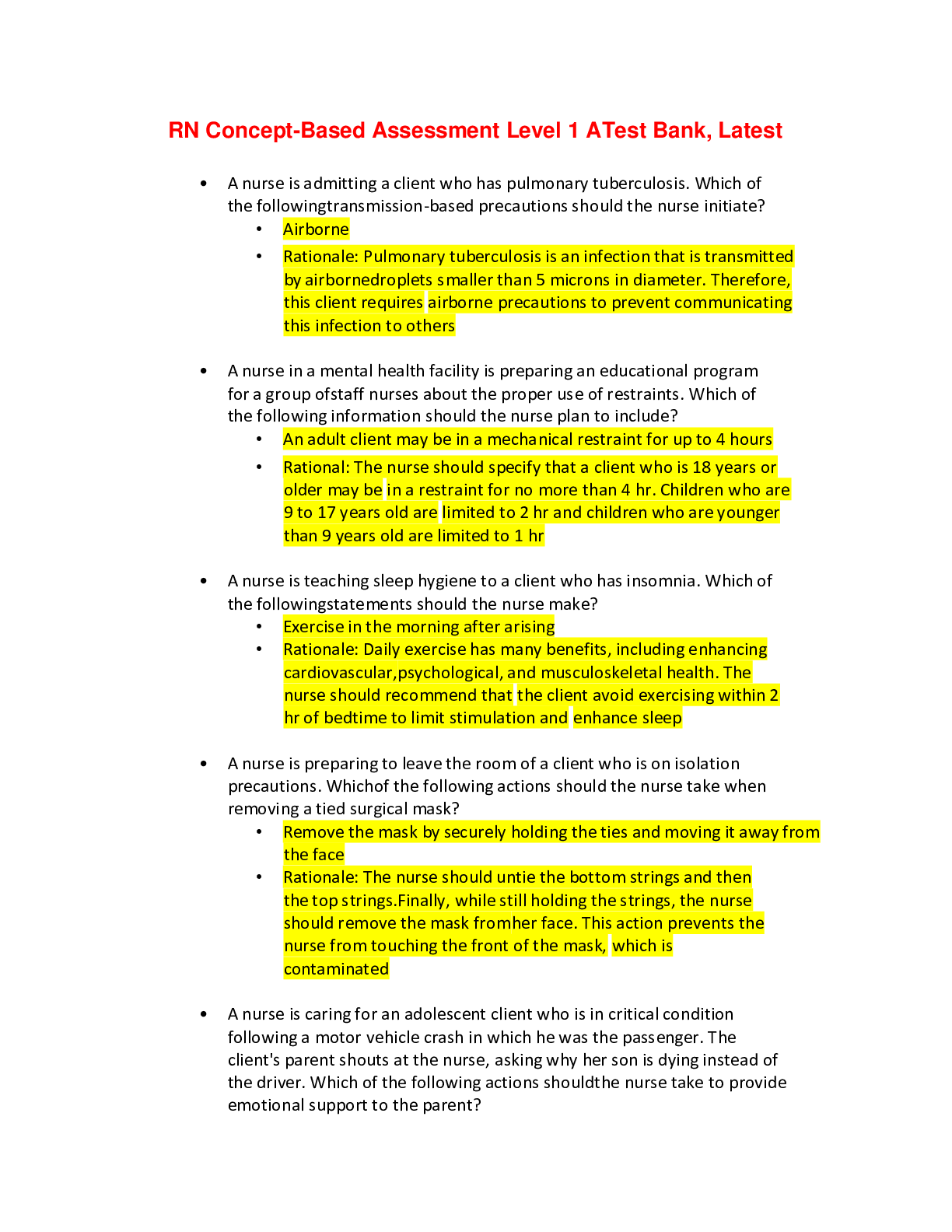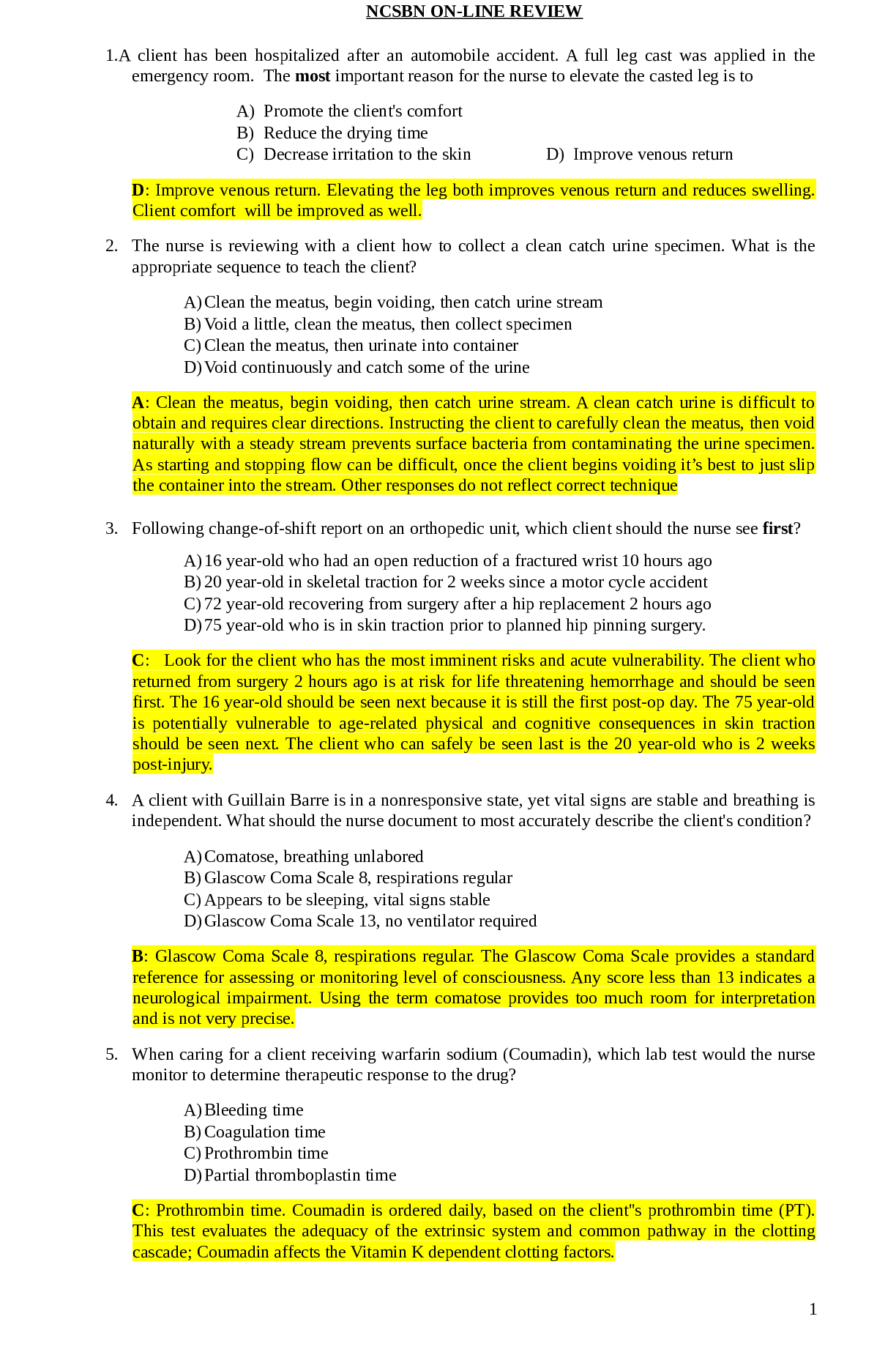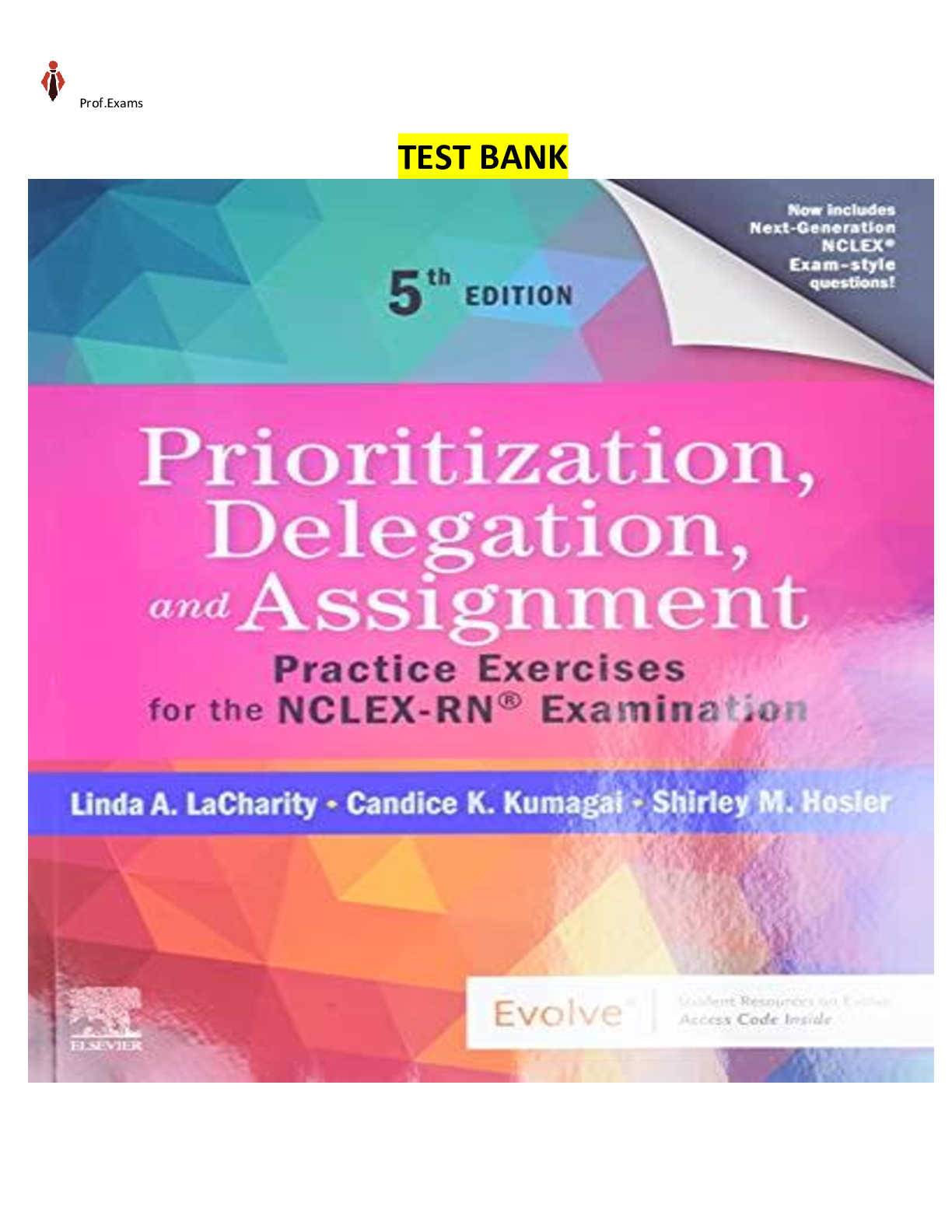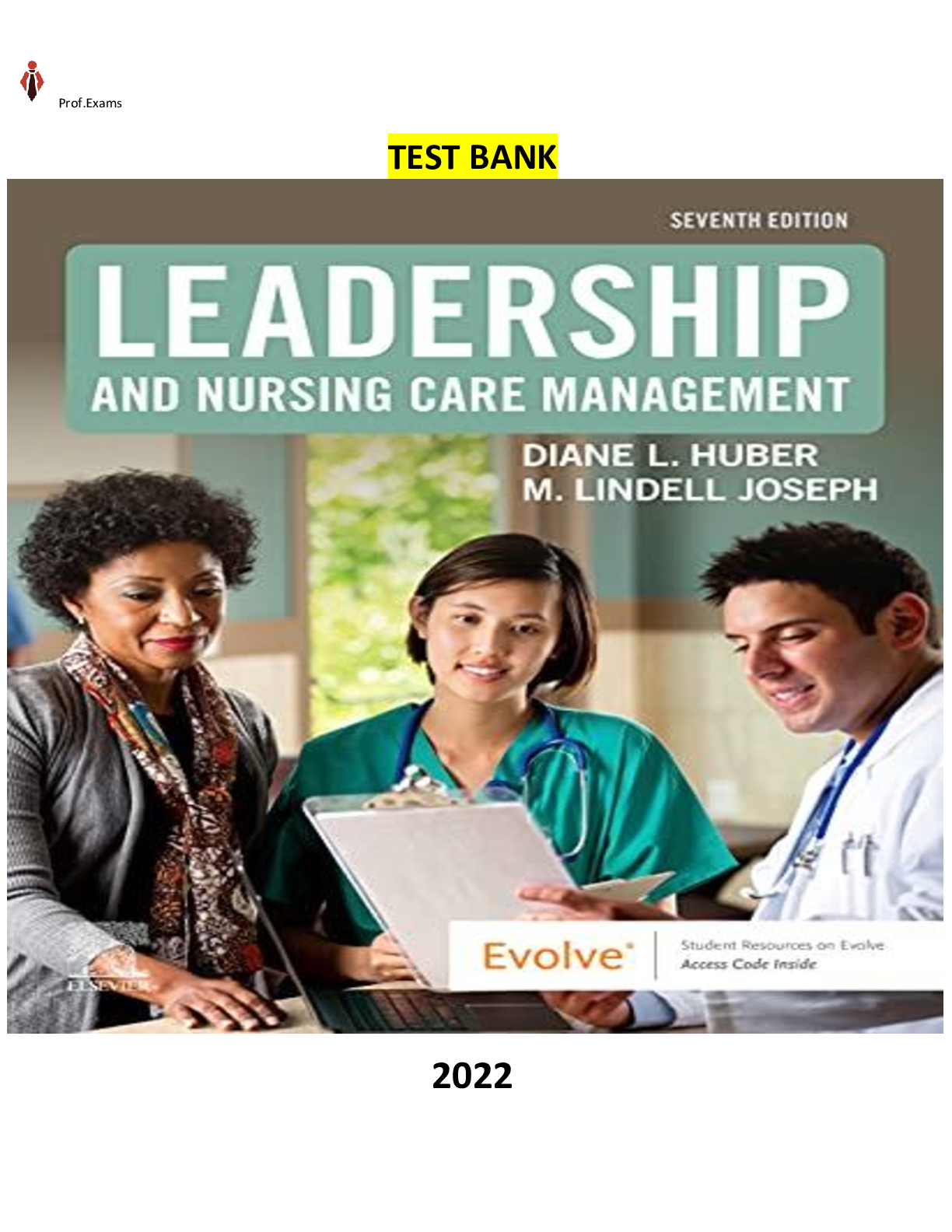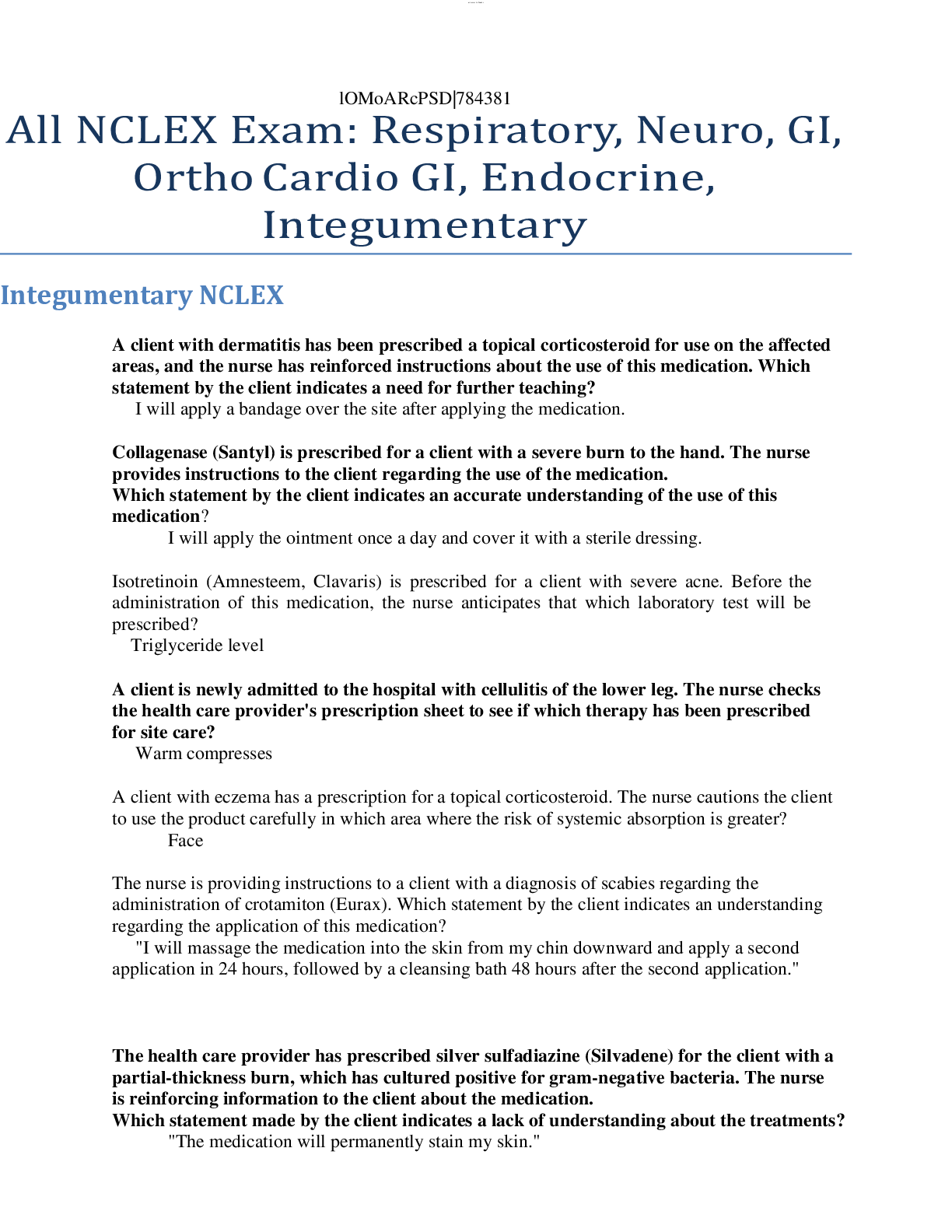*NURSING > TEST BANK > Chapter 11: NURS 340 Preparation For The Nclex Questions and Answers Test Bank,100% CORRECT (All)
Chapter 11: NURS 340 Preparation For The Nclex Questions and Answers Test Bank,100% CORRECT
Document Content and Description Below
Chapter 11: NURS 340 Preparation For The Nclex Questions and Answers Test Bank Origin: Chapter 11, 1 1. The nurse working in the emergency room monitors the admission of children. Statistically, fo... r which disorder would children younger than 5 years most commonly be admitted? A) Mental health problems B) Injuries C) Respiratory disorders D) Gastrointestinal disorders Ans: C Feedback: According to Child Health USA 2010, diseases of the respiratory system, such as asthma and pneumonia, account for the majority of hospitalizations in children younger than 5 years of age, while diseases of the respiratory system, mental health problems, injuries, and gastrointestinal disorders lead to more hospitalizations in older children. Origin: Chapter 11, 2 2. The nurse is caring for a 7-year-old girl hospitalized in isolation. The nurse notices that she has begun sucking her thumb and changing her speech patterns to those of a toddler. What condition is the girl manifesting? A) Regression B) Suppression C) Repression D) Denial Ans: A Feedback: Sucking the thumb and changing of speech pattern (such as to baby talk) are signs of regression, a defense mechanism used by children to deal with unpleasant experiences by returning to a previous stage that may be more comfortable to the child. Suppression is a conscious inhibition of an idea or desire. Repression is an unconscious inhibition of an idea or desire. Denial would be exhibited by expressions of resignation instead of true contentment, not thumb sucking or baby talk. Origin: Chapter 11, 3 3. The nurse is caring for an 8-year-old boy hospitalized for a bone marrow transplant. His parents are in and out of his room throughout the day. Which behaviors of the child would alert the nurse that he is in the second stage of separation anxiety? A) He ignores his parents when they return to his room. B) He cries uncontrollably whenever they leave. C) He forms superficial relationships with his caregivers. D) He sits quietly and is uninterested in playing and eating. Ans: D Feedback: Separation anxiety consists of three stages—protest, despair, and detachment. In the protest stage, the child reacts aggressively to separation and exhibits great distress by crying, expressing agitation, and rejecting others who attempt to offer comfort. In the despair phase the child displays hopelessness by withdrawing from others, becoming quiet without crying, and exhibiting apathy, depression, lack of interest in play and food, and overall feelings of sadness. In the detachment stage the child shows interest in the environment, starts to play again, and forms superficial relationships with the nurses and other children. If the parents return, the child ignores them. A child in this phase of separation anxiety exhibits resignation, not contentment. Origin: Chapter 11, 4 4. The nurse is caring for a 4-year-old girl who has been hospitalized for over a week with severe burns. Which would be a priority intervention to help satisfy this preschool child's basic needs? A) Encourage friends to visit as often as possible. B) Suggest that a family member be present with her 24 hours a day. C) Explain necessary procedures in simple language that she will understand. D) Allow her to make choices about her meals and activities as much as permitted. Ans: C Feedback: Preschoolers fear mutilation and are afraid of intrusive procedures since they do not understand the body's integrity. They interpret words literally and have an active imagination; therefore, procedures should be demonstrated and/or explained in simple terms. Adolescents typically do not experience separation anxiety from being away from their parents; instead, their anxiety comes from being separated from friends, and therefore encouraging friends to visit is a priority intervention. Toddlers are especially susceptible to separation anxiety and would benefit from a family member being present as much as possible. School-age children are accustomed to controlling self-care and typically are highly social; they would benefit from being involved in choices about meals and activities. Origin: Chapter 11, 5 5. The nurse is caring for a hospitalized 13-year-old girl, who is questioning everything the medical staff is doing and is resistant to treatment. How should the nurse respond? A) "Let's work together to plan your day along with your treatments." B) "The sooner you cooperate, the sooner you are going to leave." C) "If you are more cooperative, perhaps we can arrange a visit from friends." D) "Please don't make me call your parents about this." Ans: A Feedback: Collaborating with the adolescent will provide the teen with increased control. The nurse should work with the teen to provide a mutually agreeable schedule that allows for the teen's preferences while incorporating the required nursing care. Threatening to call the parents will most likely promote further resistance. The nurse should try to immediately engage the girl, rather than making the nurse's cooperation conditional upon the girl's cooperation. Telling the girl that the sooner she cooperates, the sooner she will leave is inappropriate. The nurse is incorrectly implying that her behavior, rather than her medical needs, is going to determine when she will be discharged from the hospital. Origin: Chapter 11, 6 6. The nurse is caring for a 10-year-old boy who is in traction. The boy has a nursing diagnosis of deficient diversional activity related to confinement in bed that is evidenced by verbalization of boredom and lack of participation in play, reading, and schoolwork. What would be the best intervention? A) Offer the child reading materials. B) Enlist the aid of a child life specialist. C) Encourage the child to complete his homework. D) Ask for the parents' assistance. Ans: B Feedback: The nurse should enlist the aid of a child life specialist to provide suggestions for appropriate activities. Offering the child reading materials or encouraging him to complete his homework would most likely be met with resistance as he has already verbalized his boredom and disinterest in play, reading, and schoolwork. The parents could offer the child life specialist ideas about the boy's likes and dislikes; however, the child life specialist could offer expertise in assisting hospitalized children. Origin: Chapter 11, 7 7. The nurse is caring for a 13-year-old girl hospitalized for complications from type 1 diabetes. The girl has a nursing diagnosis of powerlessness related to lack of control of multiple demands associated with hospitalization, procedures, treatments, and changes in usual routine. How can the nurse help promote control? A) Ask the child to identify her areas of concern. B) Encourage participation of parents in care activities. C) Offer the girl as many choices as possible. D) Enlist the family's assistance in creating a time schedule. Ans: C Feedback: The nurse needs to offer the girl as many choices as possible, such as options for food and drink (as her diet allows), hygiene, activities, or clothing options to promote feelings of individuality and control. Two of the other options engage the parents in the process. A 13-year-old girl is capable of making her own choices regarding activities, schedules, and routine, but she may not be able to identify her areas of concern. Origin: Chapter 11, 8 8. The nurse is caring for an 8-year-old girl who requires numerous venipunctures and injections daily. The nurse understands that the child is exhibiting signs of sensory overload and enlists the assistance of the child life specialist. What should the therapeutic play involve to best deal with the child's stressors? A) Puppets and dolls B) Drawing paper and crayons C) Wooden hammer and pegs D) Sewing puppets with needles Ans: D Feedback: The nurse understands that the child may benefit from supervised needle play to assist the child undergoing frequent blood work, injections, or intravenous procedures. The child life specialist can determine what form of therapeutic play is best, but the nurse can recommend interventions based on his or her knowledge of the specific child. Origin: Chapter 11, 9 9. After teaching a group of students about therapeutic play, the instructor determines that additional teaching is needed when the students identify what as a characteristic of therapeutic play? A) Focus on coping B) Use of a highly structured format C) Dramatization of emotions D) Expression of feelings Ans: B Feedback: Therapeutic play is nondirected play, focused on helping the child cope with feelings and fears. Real-life stressors and emotions can be acted out or dramatized, allowing the child to express his or her feelings. Origin: Chapter 11, 10 10. The mother of a hospitalized child reports that her daughter, who is having some difficulty eating, just had a 4-ounce cup of ice chips. The nurse documents this on the child's intake flow sheet as how much? A) 2 ounces B) 4 ounces C) 6 ounces D) 8 ounces Ans: A Feedback: Ice chips are included as fluid intake, and the amount is approximately equivalent to half the same amount of water. Therefore, the nurse would document this fluid intake as 2 ounces. Origin: Chapter 11, 11 11. The nurse is preparing a nursing care plan for a child hospitalized for cardiac surgery. Which are examples of interventions that nurses perform in the 'building a trusting relationship' stage? Select all that apply. A) Gathering information about the child using the child's own toys B) Preparing the child for a procedure by playing games C) Explaining in simple terms what will happen during surgery D) Allowing the child to devise an exercise plan following surgery E) Praising the child for how well he is doing following instructions F) Giving the child a favorite toy to cuddle following a painful procedure Ans: B, C Feedback: The introduction phase involves the initial contact with children and their families and it establishes the foundation for a trusting relationship. A trusting relationship can be built by using appropriate language, games, and play such as singing a song during a procedure, preparing the child adequately for procedures, and providing explanations and encouragement. In the decision-making phase, the nurse gives some control over to the child by allowing him to participate in making certain decisions, such as devising an exercise. Finally, the comfort and reassurance phase uses techniques such as praising the child and providing opportunities to cuddle with a favorite toy. Origin: Chapter 11, 12 12. The nurse is preparing a hospitalized 7-year-old girl for a lumbar puncture. Which actions would help reduce her stress related to the procedure? Select all that apply. A) Pretend to perform the procedure on her doll. B) Explain the procedure to her in medical terms. C) Do not allow her to see or touch the equipment. D) Teach her the steps of the procedure. E) Tell her not to pay attention to any sounds she might hear. F) Introduce her to the health care personnel. Ans: A, D, F Feedback: Useful techniques for reducing stress in children include the following: perform nursing care on stuffed animals or dolls and allow the child to do the same, teach the child the steps of the procedure or inform him or her exactly what will happen during the hospital stay, introduce the child to the health care personnel with whom he or she will come in contact, avoid the use of medical terms, allow the child to handle some equipment, show the child the room where he or she will be staying, explain the sounds the child may hear, and let the child sample the food that will be served. Origin: Chapter 11, 13 13. The nurse is performing an admission of a 10-year-old boy. Which actions will help the nurse establish a trusting and caring relationship with the child and his family? Select all that apply. A) The nurse should not minimize the child's fears by smiling. B) The nurse should initiate introductions. C) The nurse should not use formal titles at the introduction. D) The nurse should maintain eye contact at the appropriate level. E) The nurse should start communication with the child first and then move on to the family. F) The nurse should use age-appropriate communication with the child. Ans: B, D, F Feedback: Regardless of the site of care, nursing care must begin by establishing a trusting, caring relationship with the child and family. The nurse should smile, start introductions, give his or her title, and let the child and family know what will happen and what is expected of them. The nurse should also maintain eye contact at the appropriate level, communicate with children at age-appropriate levels, and, with a younger child, start with the family first so the child can see that the family trusts you. Origin: Chapter 11, 14 14. The nurse is caring for an 11-year-old girl preparing to undergo a magnetic resonance imaging (MRI) scan. Which statement would best help prepare the girl for the test and decrease anxiety? A) "You won't hear a sound if you wear your headphones." B) "The machine makes a very loud rattle; however, headphones will help." C) "There are a variety of loud sounds you will hear." D) "The MRI scanner sounds like a machine gun." Ans: B Feedback: The nurse should acknowledge that an MRI is loud and briefly describe the noises the machine makes. Then, the nurse should immediately offer a solution: headphones. Telling the girl she won't hear a sound is untrue. Telling her that there are loud sounds isn't enough and could increase anxiety. Comparing the MRI scanner to the sound of a machine gun is not appropriate imagery for a child. Origin: Chapter 11, 15 15. The nurse is caring for a 10-year-old girl who is in an isolation room. Which intervention would be a priority intervention for this child? A) Reduce noise as much as possible. B) Provide age-appropriate toys and games. C) Discourage visits from family members. D) Put on mask prior to entering the room. Ans: B Feedback: Children in this setting may experience sensory deprivation due to the limited contact with others and the use of personal protective equipment such as gloves, masks, and gowns. The nurse should stimulate the child by playing with her with age-appropriate toys/games. Reducing noise would be appropriate for sensory overload. The nurse should encourage the family to visit often, introduce himself or herself before entering the room, and allow the child to view his or her face before applying a mask. Origin: Chapter 11, 16 16. An adolescent is scheduled for outpatient arthroscopic surgery on his knee next week. As part of preparing him for the procedure, which action would be most appropriate? A) Discussing the events with the adolescent and his mother upon arrival the morning of the procedure B) Providing detailed explanations of the procedure at least a week in advance of the procedure C) Encouraging the parent to stay with the adolescent as much as possible before the procedure D) Answering the adolescent's questions with simple answers, encouraging him to ask the surgeon Ans: B Feedback: The adolescent needs a detailed explanation about the procedure at least 7 to 10 days beforehand. Waiting until the morning of the procedure would be inappropriate. However, information could be clarified and additional questions could be answered at this time. Having the parent stay with the adolescent is something that the adolescent would need to decide; he may or may not want a parent present. Referring the adolescent to the surgeon for his questions is inappropriate and ignores the adolescent's desire for control and information. Origin: Chapter 11, 17 17. The nurse is providing developmentally appropriate care for a toddler hospitalized for observation following a fall down the steps. Which measures might the nurse consider when caring for this child? Select all that apply. A) Use the en face position when holding the toddler. B) Use a bed for toddlers who have an adult present. C) Avoid leaving small objects that can be swallowed in the bed. D) Explain activities in concrete, simple terms. E) Allow the child to select meals and activities. F) Encourage parents to stay to prevent separation anxiety. Ans: C, F Feedback: For a toddler, the nurse would avoid leaving small objects that can be swallowed in the bed and encourage parents to stay to prevent separation anxiety. The nurse would use the en face position when holding an infant and use a bed only for the older toddler who has an adult present in the room at all times. The nurse would explain activities in concrete, simple terms for a preschooler and allow a school-age child to select meals and activities. Origin: Chapter 11, 18 18. The nurse is ordered to apply restraints to a toddler who keeps pulling at the tubes in his arm. Which criteria must occur to ensure proper use of these restraints? Select all answers that apply. A) The nurse must check the restraints every 15 minutes while they are in place. B) Secure the restraints with ties to the side rails, not the bed or crib frame. C) Assess the temperature of the affected extremities, pulses, and capillary refill every 15 minutes after placement. D) Use a clove-hitch type of knot to secure the restraints with ties. E) Remove the restraint every 2 hours to allow for range of motion and repositioning. F) Encourage parent participation, providing continuous explanations about the reasons and time frame for restraints. Ans: D, E, F Feedback: The nurse should use a clove-hitch type of knot to secure the restraints with ties, remove the restraint every 2 hours to allow for range of motion and repositioning, and encourage parent participation, providing continuous explanations about the reasons and time frame for the restraints. The nurse must check restraints 15 minutes following initial placement and then every hour for proper placement and secure the restraints with ties to the bed or crib frame, not the side rails. The nurse should also assess the temperature of the affected extremities, pulses, and capillary refill, initially after 15 minutes and then every hour after placement. Origin: Chapter 11, 19 19. The nurse is caring for a 7-year-old boy who needs his left leg immobilized. What is the priority nursing intervention? A) Enlist the assistance of a child life specialist. B) Explain to the boy that he must keep his leg very still. C) Apply a clove-hitch restraint to the boy's left leg. D) Explain that a restraint will be applied if he cannot hold still. Ans: B Feedback: An explanation about the desired goal is necessary and appropriate for a 7-year-old child to understand what is required. In many cases, this will be all that is needed. Explaining that a restraint will be applied if the boy cannot hold still will likely be perceived as a threat or punishment. All alternative measures need to be tried before the use of restraints. Enlisting the assistance of the child life specialist is not a priority. Origin: Chapter 11, 20 20. The nurse is transporting a 6-month-old with a suspected blood disorder to the nursery. What is the most appropriate method of transporting the child by the nurse? A) A wagon with rails B) Cradle hold C) Football hold D) Over-the-shoulder Ans: D Feedback: A 6-month-old should be carried in the "over-the-shoulder" method. A wagon with rails is for an older child. A cradle hold is for infants until 3 months of age. A football hold is for infants until 2 months of age. Origin: Chapter 11, 21 21. The nurse is caring for an immunosuppressed 3-year-old girl and is providing teaching to the mother about proper oral hygiene. Which response from the mother indicates a need for further teaching? A) "I really need to carefully check for skin breakdown." B) "I must really scrub her teeth and gums well." C) "I must use a soft toothbrush." D) "I can use a soft gauze sponge to care for her gums." Ans: B Feedback: The nurse should caution the mother that overly vigorous brushing should be avoided as it can injure or irritate the gums. The other statements are recommended guidelines for care. Origin: Chapter 11, 22 22. When preparing to apply a restraint to a child, what would be most important for the nurse to do? A) Expect to keep the restraint on for at least 8 hours. B) Explain that safety, not punishment, is the reason for the restraint. C) Plan to use a square knot to secure the restraint to the side rails. D) Use a limb restraint rather than a jacket restraint for most issues. Ans: B Feedback: Before applying a restraint, the nurse needs to explain the reason for the restraint to the child, emphasizing that the restraint is for safety, not to punish the child. The least restrictive type of restraint should be used, and it should be applied for the shortest time necessary. A clove-hitch knot is used to secure the restraint with ties to the bed or crib frame, not the side rails. Origin: Chapter 11, 23 23. The nurse is providing discharge planning for a 12-year-old boy with multiple medical conditions. What would be the best teaching method for this child and his family? A) Demonstrate the care and ask for a return demonstration. B) Provide and review educational booklets and materials. C) Provide a written schedule for the child's care. D) Provide a trial period of home care. Ans: D Feedback: Parents of children with multiple medical needs may benefit from a trial period of home care. This occurs while the child is still in the hospital, but the parents or caregivers provide all of the care that the child requires. The other options are also important teaching methods, but a trial period is the best solution for a child with multiple medical conditions. Origin: Chapter 11, 24 24. The nurse is working as a community health care nurse. What would be the nurse's focus when providing care of the child? A) Providing care to the individual and family in acute care settings B) Providing care to the indigent in family care settings C) Providing care in geographically and culturally diverse settings D) Providing care for particular age groups or particular diagnoses Ans: C Feedback: Community health nurses work in geographically and culturally diverse settings. They address current and potential health needs of the population or community. Community- based nursing focuses more on providing care to the individual or family (which, of course, impacts the community) in settings outside of acute care. They promote and preserve the health of a population and are not limited to particular age groups, income levels, or diagnoses. Origin: Chapter 11, 25 25. The nurse working in community nursing uses epidemiology as a tool. What information can be obtained using this process? A) Health needs of a population B) Cultural needs of a population C) Income levels of a population D) Mortality rates of a population Ans: A Feedback: Epidemiology can help determine the health and health needs of a population and assist in planning health services. Community health nurses perform epidemiologic investigations in order to help analyze and develop health policy and community health initiatives. The nurse provides culturally competent care but does not use epidemiology to determine culture, income levels, or mortality rates of children. Origin: Chapter 11, 26 26. When speaking to a group of parents at a local elementary school, the nurse describes school nursing as a specialized practice of nursing based on the fact that a healthy child has a better chance to succeed in school. What best describes the strategy school nurses use to achieve student success? A) They coordinate all school health programs. B) They link community health services. C) They work to minimize health-related barriers to learning. D) They promote student health and safety. Ans: C Feedback: School nurses work to remove or minimize health barriers to learning to give students the best opportunity for academic success. Coordinating school health programs, linking community health programs, and promoting health and safety are individual components within the ultimate goal of removing or minimizing health barriers. Origin: Chapter 11, 27 27. The nurse referring a child to home care discusses the advantages and disadvantages with the child's family. What are disadvantages of this method of health care? Select all that apply. A) The nurse is performing care of the child in the family's home. B) The home care nurse is not always equipped to perform technical care. C) The out-of-pocket cost of home care is more expensive. D) The technical procedures may be overwhelming for the family. E) The financial burden may cause more stress for the family. F) The child does not receive continuity of care provided in the hospital setting. Ans: A, C, D, E Feedback: There are some disadvantages to home care. The presence of health care professionals in the home can be an intrusion on family privacy. Financial issues can become a large burden: families may have higher out-of-pocket costs if their insurance does not reimburse for home care. Having one parent at home full time and not earning an income can contribute to increased financial strain, not to mention social isolation of that parent. All of these can lead to increased stress on family members. Also, caring for children with complex medical needs can be overwhelming for some families. The home care nurse should arrange for continuity of care for the child. Origin: Chapter 11, 28 28. The nurse working with children in a hospital setting notes that they are being discharged earlier and earlier. Which is a primary reason for this trend? A) Nursing shortages B) Increased funding for home care C) National health care initiatives D) Cost containment Ans: D Feedback: Over the past century changes in health care, such as strained health care funding, shorter hospital stays, and cost containment, have led to a shift in responsibilities of care for children from the hospital to homes and communities. Nursing shortages influence the delivery of health care. National health care initiatives may or may not affect earlier discharge to home health care. Origin: Chapter 11, 29 29. The nurse caring for a child on a pediatric intensive care unit notices that when the parents go to work the child is very angry and cries easily. What does the nurse suspect is occurring with this patient? A) Protest phase of separation anxiety B) Regressive behavior C) Detachment from the parents D) Despair Ans: A Feedback: The first phase of separation anxiety, protest, occurs when the child is separated from the parents or primary caretaker. This phase may last from a few hours to several days and is characterized by crying, expressing agitation, rejecting others who attempt to offer comfort, anger, and inconsolable grief. [Show More]
Last updated: 1 year ago
Preview 1 out of 14 pages

Reviews( 0 )
Document information
Connected school, study & course
About the document
Uploaded On
Feb 13, 2023
Number of pages
14
Written in
Additional information
This document has been written for:
Uploaded
Feb 13, 2023
Downloads
0
Views
32










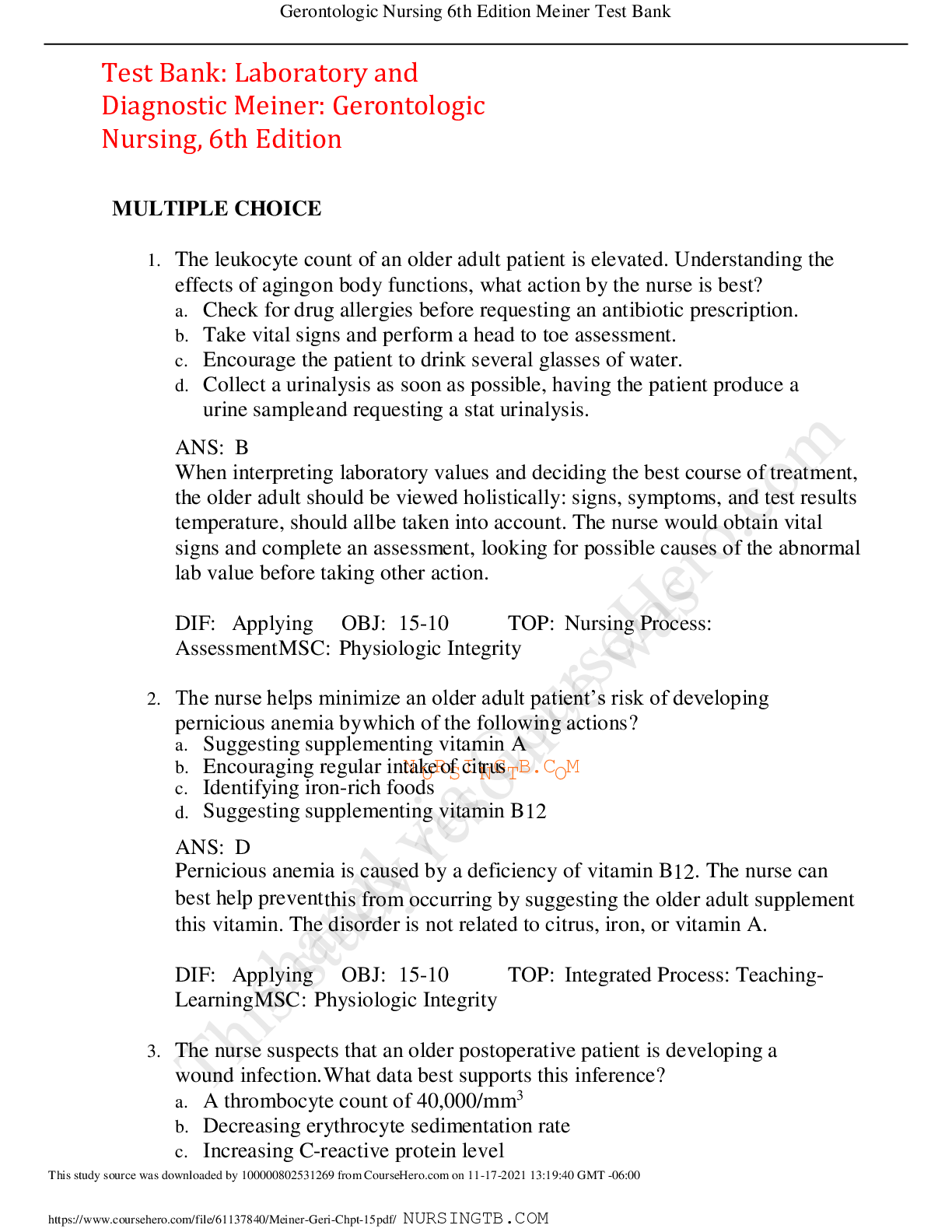


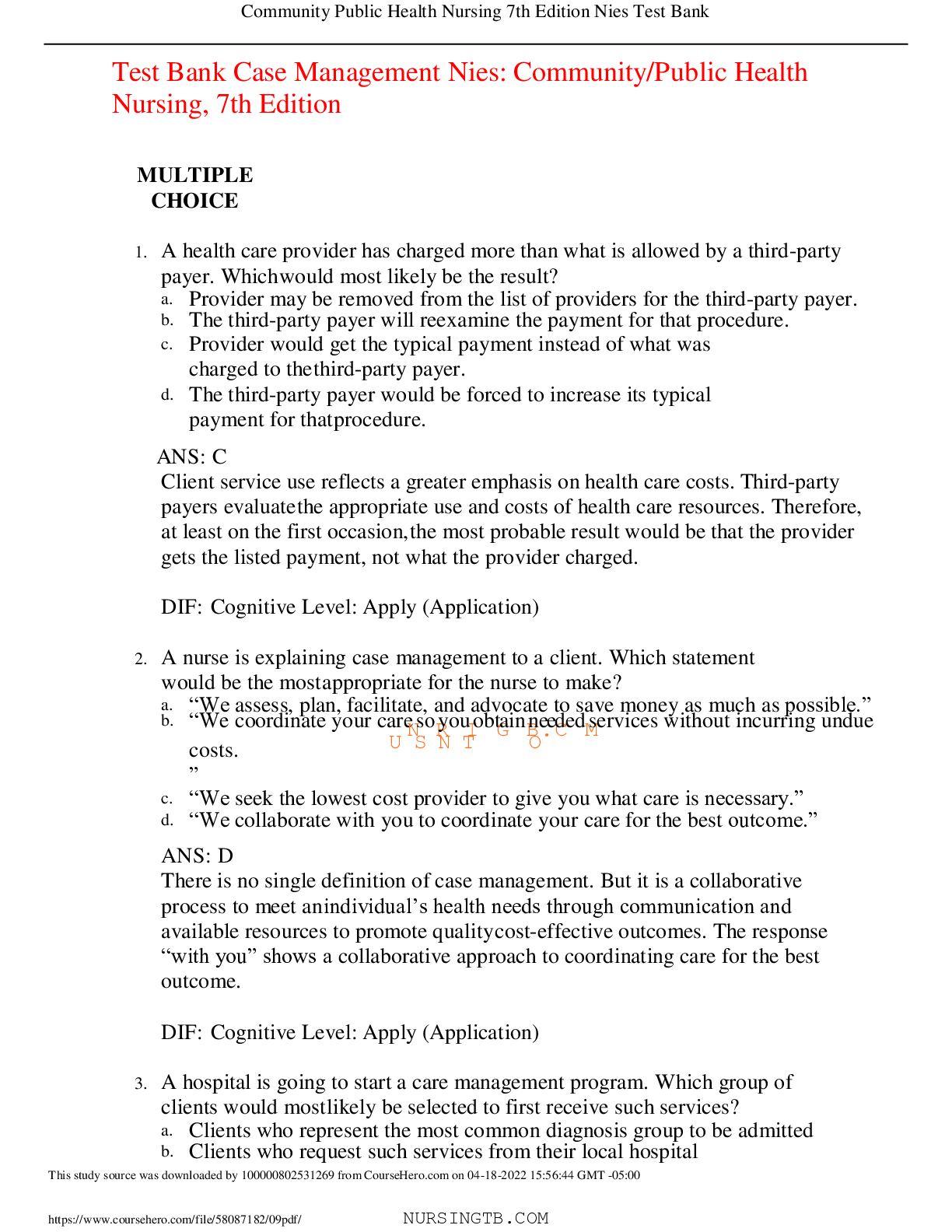


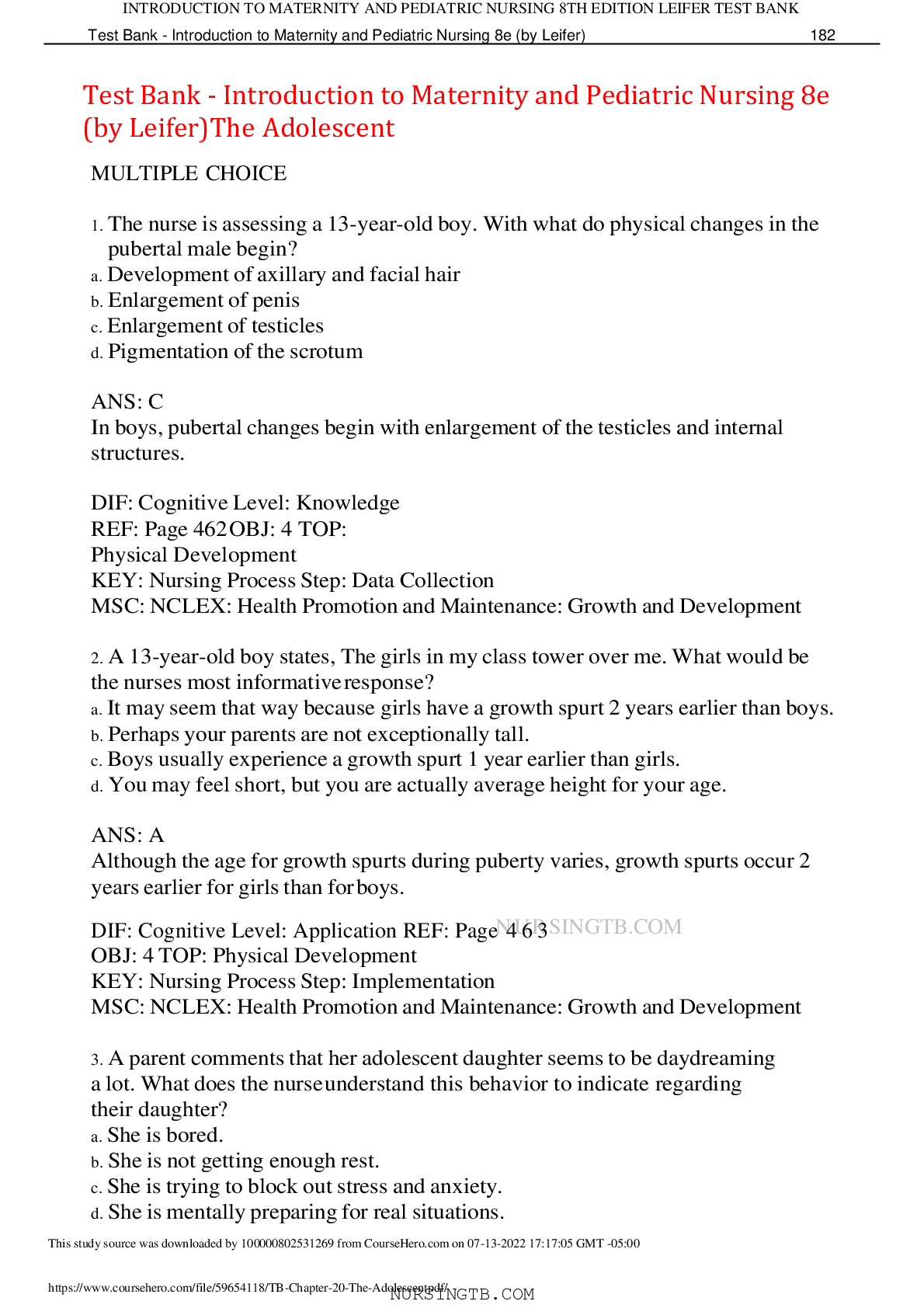
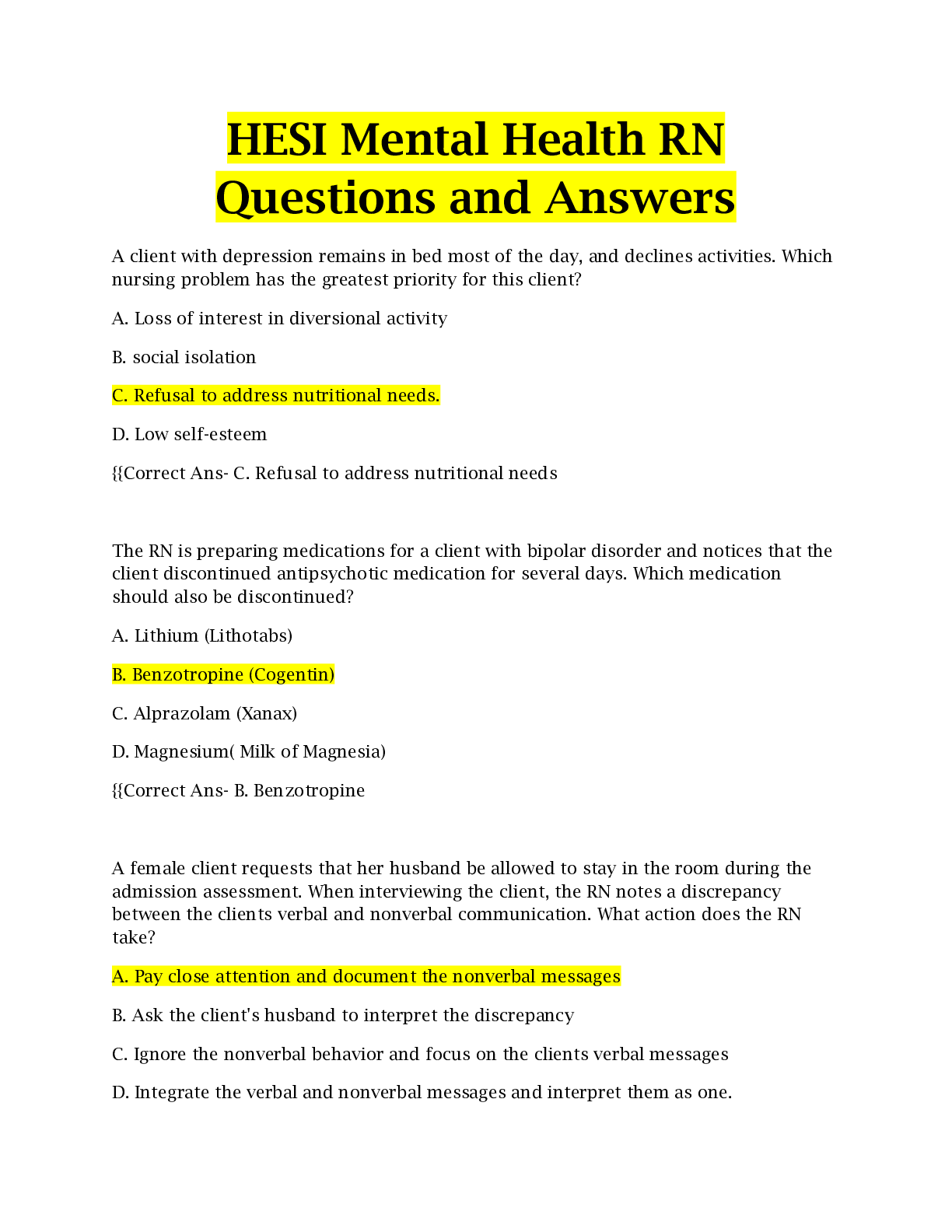



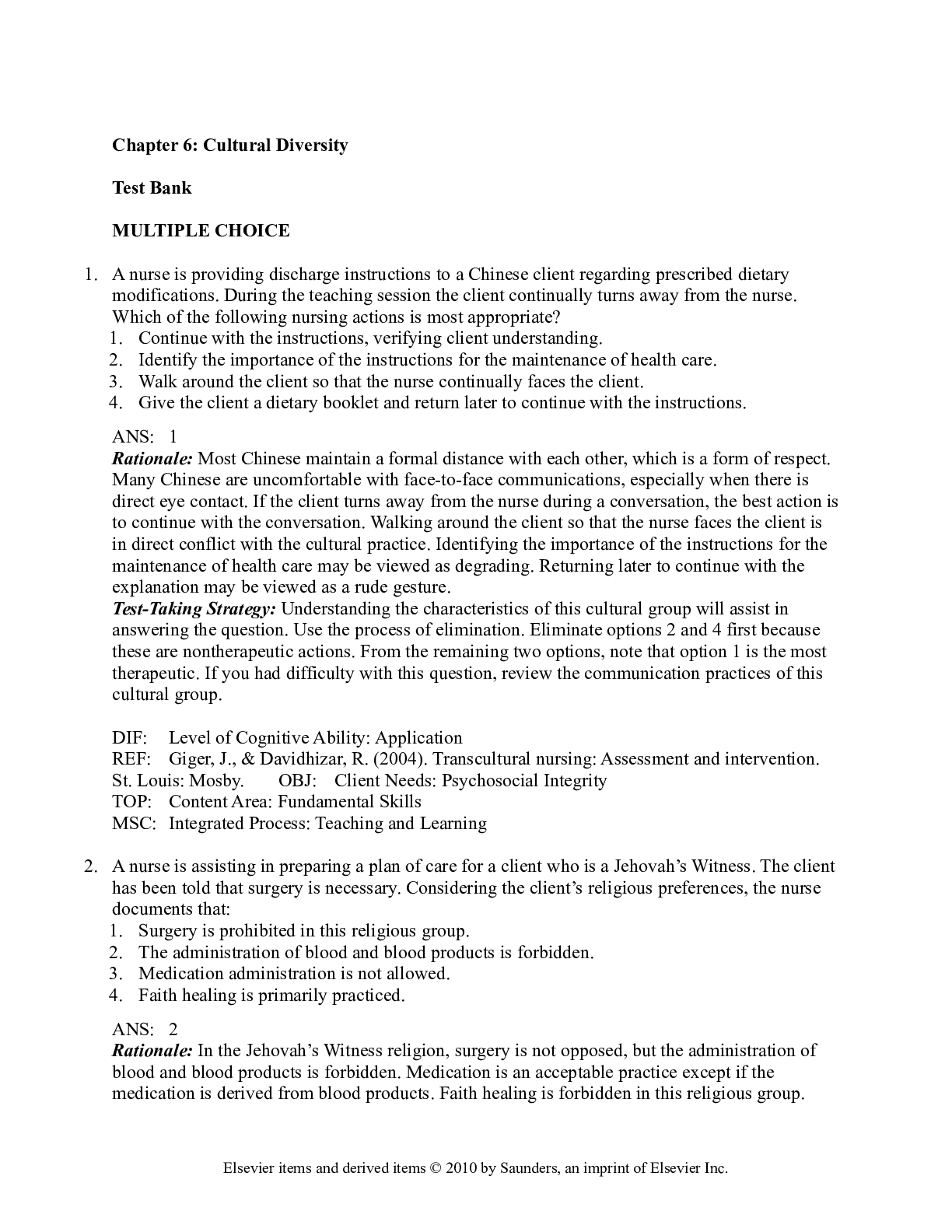
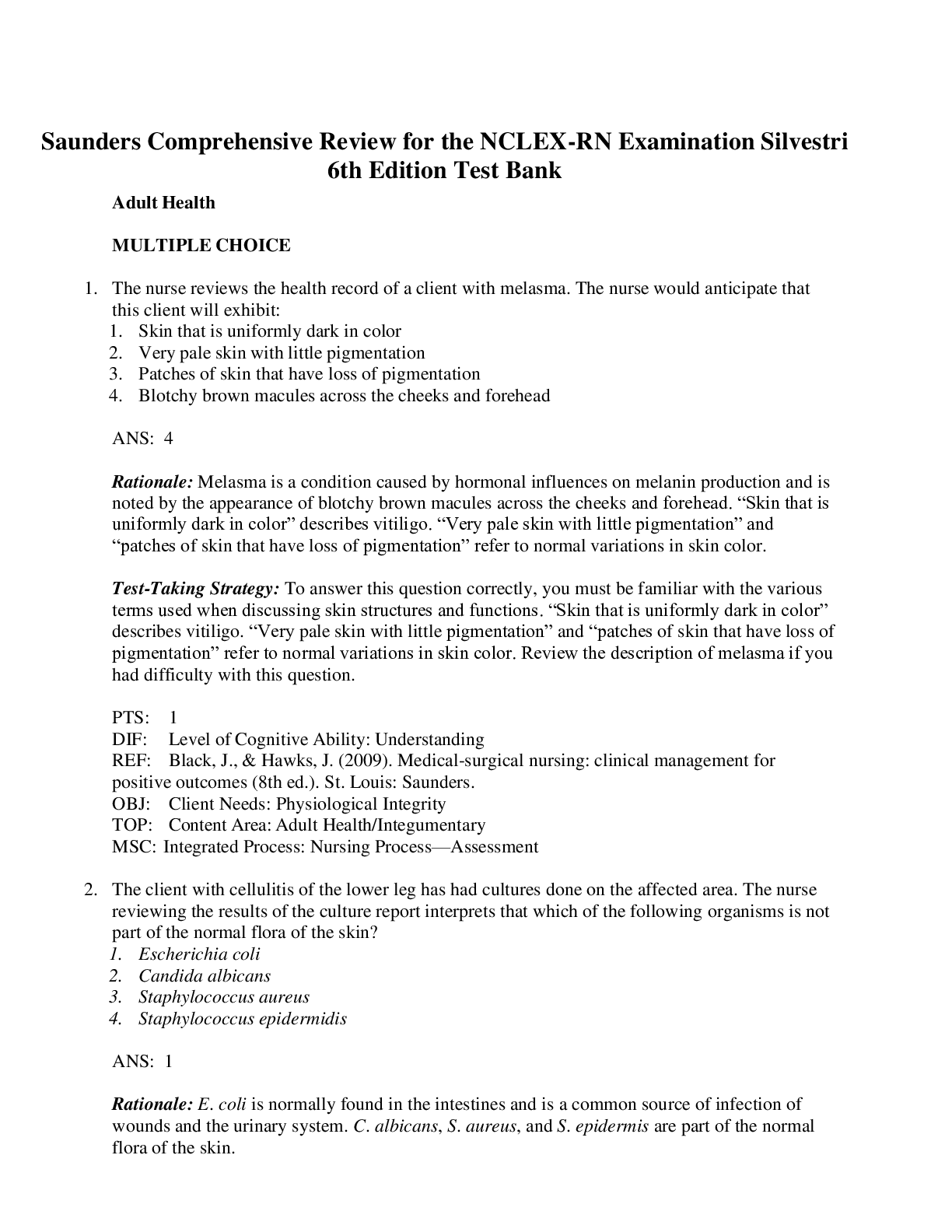
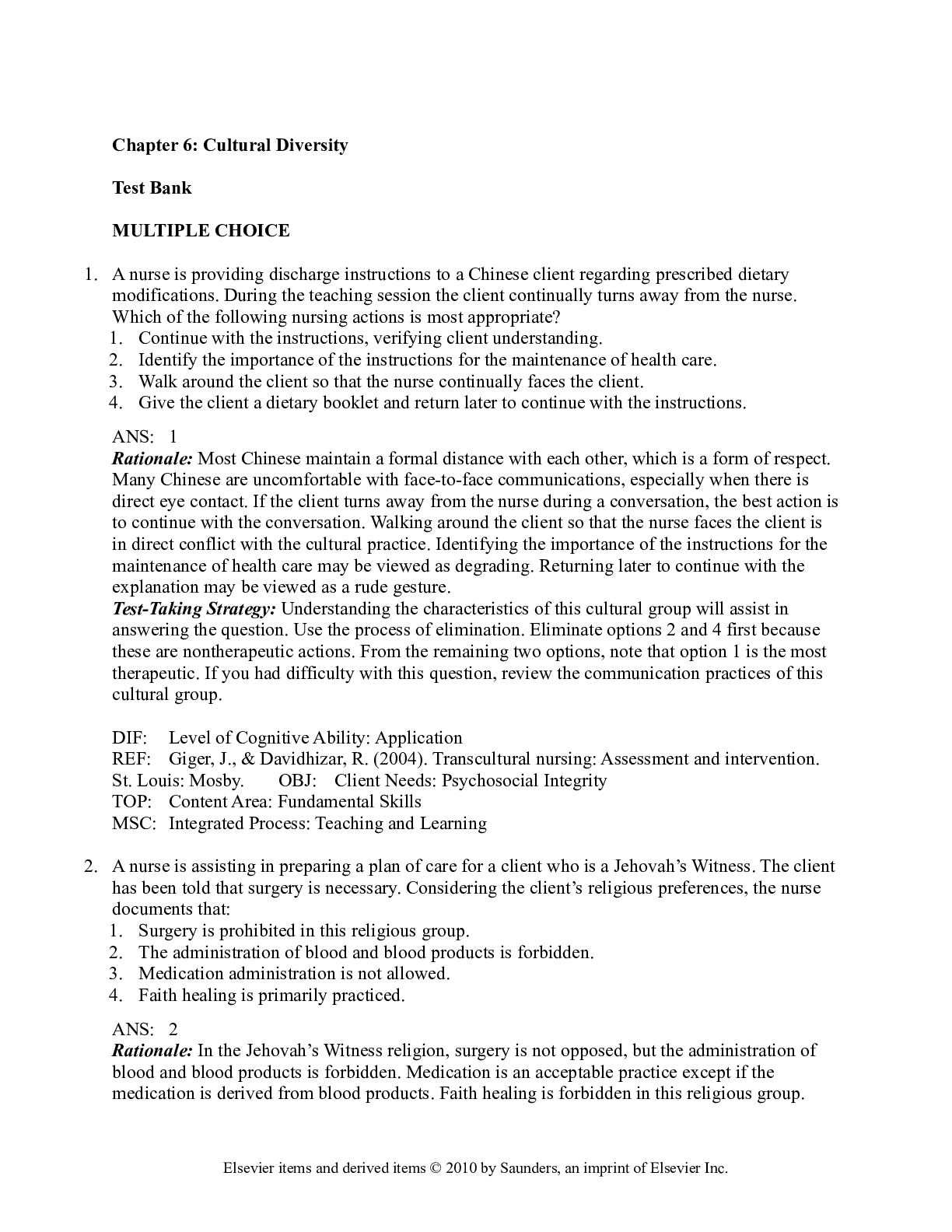

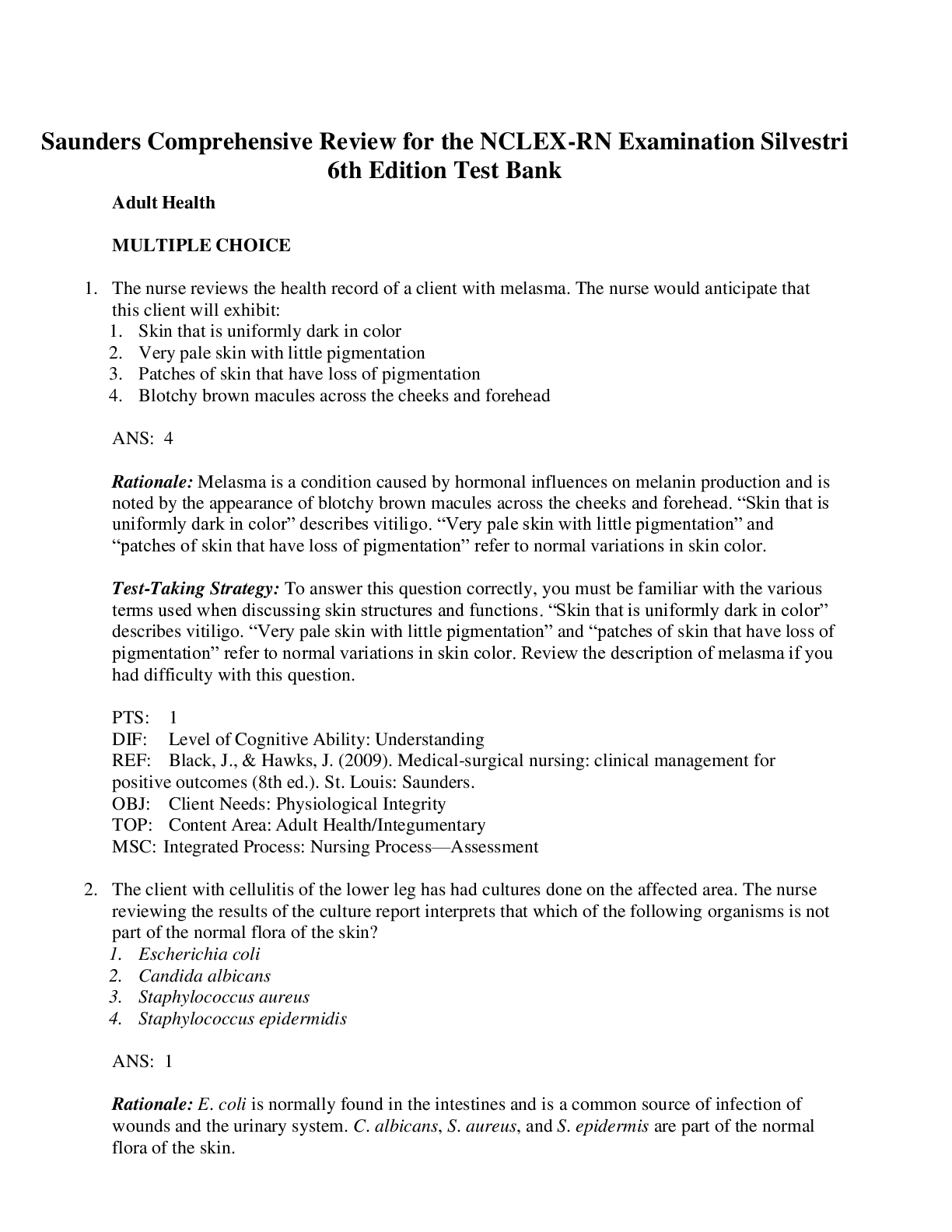
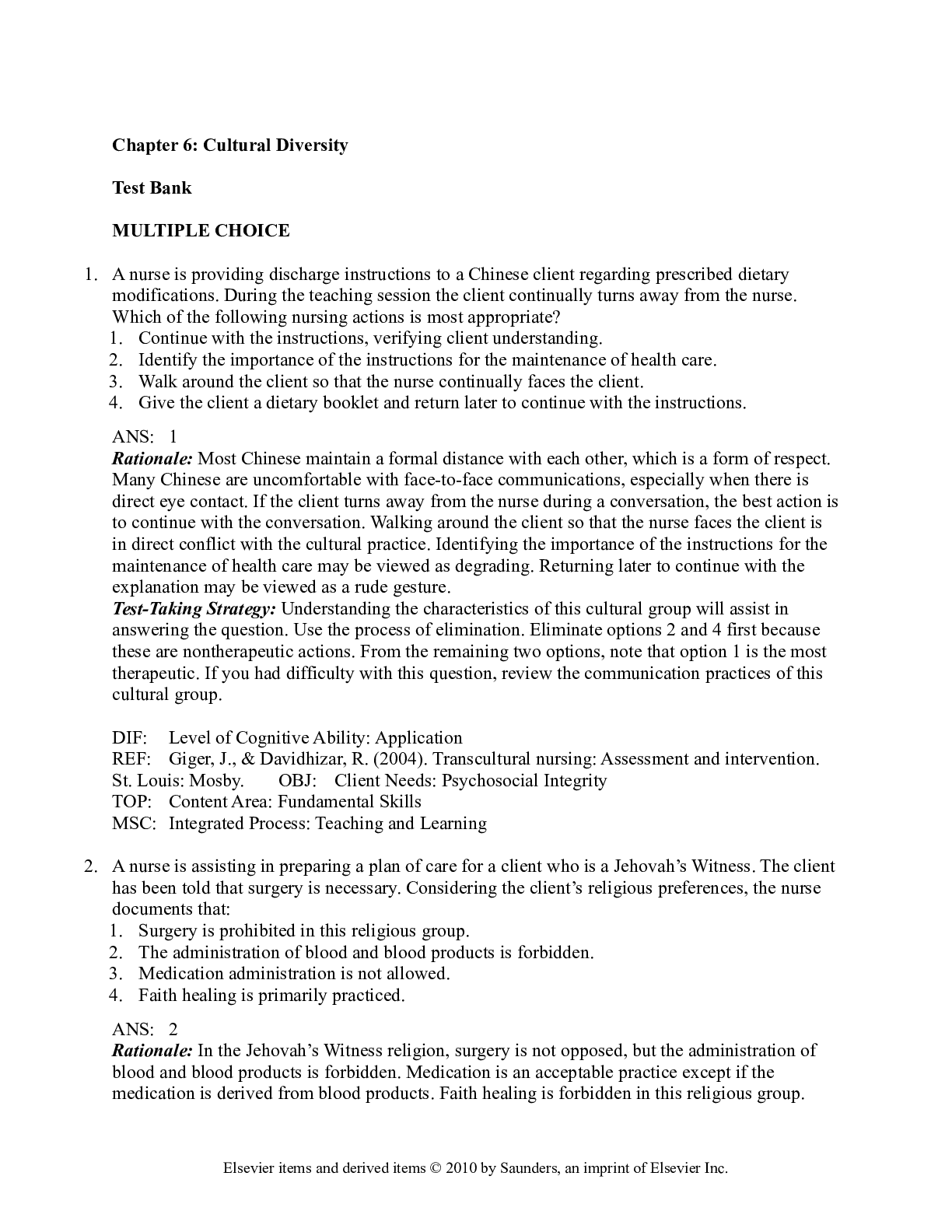


.png)
